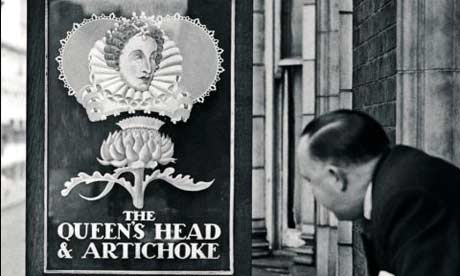 Plea to save vanishing art of the pub sign
Plea to save vanishing art of the pub sign
Conservationists are fighting a rearguard battle to save a skill dating back to Roman timesVanessa Thorpe, arts and media correspondent
The Observer,Sunday September 21 2008
Article history
Many inn signs hold historic and local significance. Photograph: Reg Speller/Getty
The painted pub sign, one of the oldest popular visual arts traditions in Britain, is locked in decline. That is the fear of conservationists who hope to alert pub chains and breweries to a 'catastrophic' loss of the traditional skills involved and a failure to preserve a heritage that dates back to Roman times.
The growing corporate ownership of public houses across the British Isles has led to the standardisation of what is on offer, both inside and outside the bar. The situation has worsened in the past five years because of the increasing number of pub closures. Figures compiled by the Campaign for Real Ale show that an average of 57 pubs shut permanently every month.
Campaigning groups such as the Royal Institute of British Architects and the Society for the Protection of Ancient Buildings, which once lobbied vigorously on behalf of this dying art, have been taken by surprise by the rate of decline. Only the small Inn Signs Society has charted the sharp fall in newly commissioned painted signs. The society, which has fewer than 400 members, aims to win a Heritage Lottery Fund grant to establish an online archive of material before the tradition disappears.
'Like the pub, the inn sign is classless and central to British culture,' argues Tim Minogue in the latest edition of the Society for the Protection of Ancient Buildings' monthly magazine. 'And like the pub, it is acutely vulnerable. Inn signs vary wildly in artistic merit, have no official status or protection, are constantly exposed to the elements and are at risk of theft and vandalism.'
Only the 30 independent pub chains and breweries in Britain are still ordering individually painted signs. The St Austell Brewery in Cornwall has a full-time sign painter and the Donnington Brewery at Stow-on-the-Wold in Gloucestershire is hanging painted signs at its 16 tied pubs. Whitbread ran a sign-painting studio in Cheltenham until 1991, but has given up brewing and now runs pub restaurant chains such as Brewers Fayre.
Inn and tavern names are often of historic significance to an area and yet corporate takeovers have led to the replacement of many with new brand names such as The Rat and Parrot, All Bar One, Pitcher and Piano, or Slug and Lettuce.
The first signs outside inns appeared after the Roman invasion when most people were unable to read. A wreath of vine leaves on a pole was the recognised symbol for a hostelry, and this led to images of shrubbery and pub names such as The Bush or The Bunch of Grapes. During the medieval era heraldry and religious symbolism took over: Cross Keys is a reference to St Peter, and the Red Lion may come from the insignia of John of Gaunt, the most prominent public figure in 14th-century England.
Minogue looks back nostalgically at the last moment of glory for painted pub signs: in November 1936 the first and last Inn Signs Exhibition was held in London, and 260 iron and timber signs were seen by 18,000 visitors. He quotes too the words of the 61-year-old artist Rob Rowland, who has painted more than 1,000 inn signs in his time. 'What is happening is a great shame,' he says. 'These corporate identities obliterate the historical significance of pubs and detach people from their roots. There are many reasons for the loss of inn signs, but it is all part of a general decline of cultural sensibility.'
Signs of the times
· The earliest 'pub sign' was a wreath of vine leaves, an idea that arrived with the Romans. But as vines are not native, they were replaced by evergreens, trees and shrubs, and eventually painted signs such as The Bush and The Yew Tree.
· In 1393 King Richard II passed a law making it compulsory for inns to have a sign in order to identify them to the official Ale Taster.
· The Cheshire Cat at Ellesmere Port, Cheshire, is said to be the first to refer to such a creature. It is not clear whether the cheese and dairy products of the area were thought to keep its felines happy.
· The name of The Mother Shipton, in Knaresborough, North Yorkshire, comes from the tale of a local woman born in a cave in the 15th century who supposedly foretold the death of Cardinal Wolsey, the Gunpowder Plot, and the invention of aircraft.
· The Victoria in St Werburghs, Bristol replaced its image of Queen Victoria in 2002 with one of Victoria Beckham - which has now changed to Little Britain's Vicky Pollard.
 Plea to save vanishing art of the pub sign
Plea to save vanishing art of the pub sign